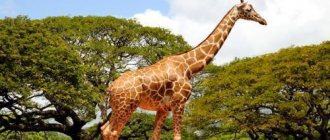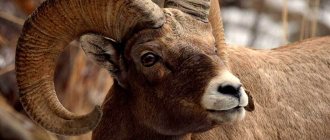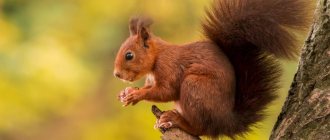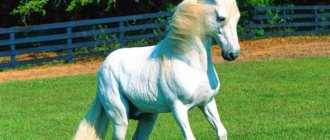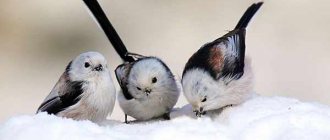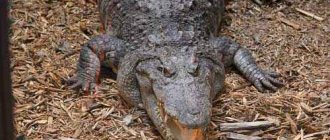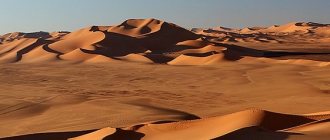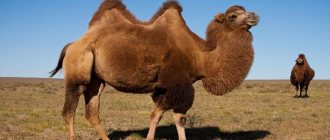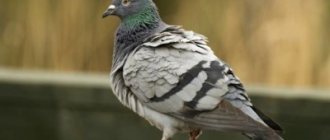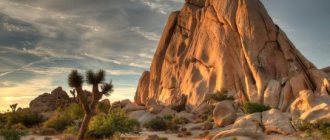4.1
Average rating: 4.1
Total ratings received: 157.
4.1
Average rating: 4.1
Total ratings received: 157.
In Russia, the natural zone of hot deserts and semi-deserts is located in the lower reaches of the Volga, occupying the Caspian lowland and adjacent areas. Polar deserts are located on the Arctic islands and the coast of Taimyr. The article reports what animals live here and how they adapt to unfavorable conditions.
Desert Mammals
Caracal
This is a desert cat. Easily kills antelope. The predator is able to do this not only with its powerful grip and dexterity, but also with its size. The length of the caracal reaches 85 centimeters. The height of the animal is half a meter. The color of the animal is sandy, the fur is short and soft. The ears have long awn tassels. This makes the caracal look like a lynx.
The desert lynx is solitary and active at night. With the onset of darkness, the predator hunts medium-sized mammals, birds, and reptiles.
The name caracal can be translated as “black ear”
Giant mole rat
A representative of the mole rat family weighs almost a kilo and is 35 centimeters long. Hence the name. The animal is blind because it leads a life similar to that of a mole. The desert dweller also digs tunnels in the ground. To do this, the animal is equipped with powerful claws and large teeth protruding from its mouth. But the mole rat does not have ears or eyes. Because of this, the animal’s appearance is intimidating.
Mole rats are desert animals that can be encountered by residents of the Caucasus and Kazakhstan. Sometimes animals are found in steppe regions. However, living underground, mole rats rarely appear above it. If this happens, the animals burrow back at lightning speed. Therefore, the habits of mole rats are poorly studied even by zoologists.
The mole rat has no eyes, it navigates by ultrasonic vibrations
long eared hedgehog
This is the smallest representative of the hedgehog family. In the desert, the animal runs the risk of overheating, which is why it has grown large ears. Unlike the rest of the body, they are naked. The open area of the skin releases excess heat into the environment. This happens due to the expansion of capillaries. Their dense network penetrates every millimeter of the hedgehog’s ears.
With a body length of 20 centimeters, the spines of the long-eared hedgehog extend by 2.5 centimeters. The color of the tips varies depending on the habitat of the mammal. Due to the coloring of the needles, the hedgehog is camouflaged among the surrounding landscape.
You can, of course, distinguish an eared hedgehog from a regular hedgehog by its large ears.
Manul
It usually settles in the steppes, but in the south of Turkmenistan it also lives in deserts. Outwardly, the manul resembles a long-haired domestic cat. However, her face is fierce. Due to the anatomical structure, a cat's face always looks unhappy. It is difficult to train a Pallas's cat. It's easier to have a caracal at home.
The ends of the Pallas' hair are white. The remaining area of the hairs is gray. As a result, the color of the animal looks silver. There are black stripes on the face and tail.
Manul is the rarest type of cat
fennec
Otherwise called desert forest. Among the red cheats, the animal is the smallest, and not red at all. Fennec fox color is sandy. The animal also differs in its ears. Their length is 15 centimeters. The purpose of wearing such large ears on a miniature body is thermoregulation, as is the case with the desert hedgehog.
Fennec ears are adaptations of desert animals that perform another function. Large sinks capture the slightest vibrations in the air. This is how the fox cub identifies reptiles, rodents and other small animals that it feeds on.
Fenech cats are often kept as pets
Dune cat
It lives in the deserts of northern Africa and central Asia. This is the first time the animal has been spotted in the sands of Algeria. The discovery dates back to the 15th century. Then a French expedition walked through the deserts of Algeria. It included a naturalist. He described a previously unseen animal.
The sand cat has a wide head with equally wide-set ears. Their shells face forward. The ears are large. There are some sort of whiskers on the cat's cheeks. There is dense fur even on the pads of the paws. This is a device that saves the skin of a predator from burns when walking on hot sand.
The sand cat is one of the most secretive animals
Meerkats
One of the few socially organized inhabitants of deserts, they live in families of 25-30 individuals. While some are getting food, others are standing guard. Rising on their hind legs, the animals inspect the surroundings for approaching predators.
Meerkats are animals of the deserts located among the savannas of Africa. There, animals of the mongoose family dig underground passages, going 2 meters deep. They hide in holes and raise children. By the way, meerkats do not have courtship. Males literally rape females, attacking and taking when the chosen one is exhausted from the fight.
Meerkats live in clans in which each has a certain status
Pereguzna
Refers to mustelids. Externally, the animal resembles a ferret with large ears and a blunt muzzle. The color of the peregrine is variegated. Black spots alternate with beige and white.
The length of the saddle is 50 centimeters including the tail. The animal weighs about half a kilogram. Being small in size, the animal is a predator, settling in the burrows of its victims. At the same time, peregrines are excellent at climbing trees. The animals do this alone, uniting with relatives only during the mating season.
In the photo there is a re-dressing or bandaging
Jerboa
Rodents cannot be more than 25 centimeters in length. Most of it comes from a long tail with a brush at the end. The body of the animal is compact. The jerboa's paws are jumping, and the hand on the tail acts as a rudder in the air.
The fauna of the desert is complemented by not a single jerboa, but about 10 species. The smallest of them do not exceed 4-5 centimeters in length.
Jerboas have a large number of enemies, which negatively affects their life expectancy
Camel
In North Africa the animal is sacred. The fur of camels reflects light, saving the “ships of the desert” from the heat. Camels store water in their humps. Some animal species have two of them, while others have one. The filler is encased in fat. When there is a lack of water, it splits, releasing moisture.
When water supplies are depleted in the humps, camels unerringly find sources of moisture. Animals can smell them at a distance of 60 kilometers. Also, “ships of the desert” have excellent vision. Camels notice movements at a distance of a kilometer. Animals also navigate among the dunes using visual memory.
A camel's humps contain not water, but adipose tissue that can be converted into energy.
Addax
This is a large antelope. It reaches 170 centimeters in length. The height of the animal is approximately 90 centimeters. The antelope weighs up to 130 kilograms. The color of the ungulate is sandy, but there are white spots on the ears and face. The head is decorated with long horns curved in a large wave.
Of all the antelopes, the addax is best adapted to life among the dunes. In the sands, ungulates find sparse vegetation, from which they obtain not only nutrients, but also water.
Antelope addax
Dorcas
The Dorcas gazelle is small and slender. The color of the animal is beige on the back and almost white on the belly. Males have folds of skin on the bridge of their nose. The horns of males are more curved. In females, the outgrowths are almost straight and about 20 centimeters long. Males' horns reach 35.
The length of the most ungulate is 130 centimeters. At the same time, the animal weighs about 20 kilograms.
Characteristics of Russian deserts
The desert zone is located on the Caspian lowland, which several thousand years ago was the seabed. This factor adds uniqueness to this natural area.
It is characterized by an absolutely flat landscape with zonal alternation of types of coverage:
- sands;
- rocky placers;
- clay;
- salt marshes.
Arctic deserts are found above 75° north latitude . The relief is predominantly flat with a characteristic patterned pattern, which arises as a result of numerous repetitions of the processes of thawing and freezing. Much of the Arctic desert remains frozen for almost the entire calendar year. The thickness of permafrost never thaws.
The soil
The soils of the Russian desert are quite diverse:
- chestnut;
- sandy;
- desert-steppe;
- clayey;
- solonetzized;
- gray soils;
- grey-brown.
There are a lot of takyrs (clayey soils in the lowest parts of the plain). The soil characteristics of Arctic deserts are poorer. The fertile horizon is thin with a small amount of nutrient fractions. Includes a lot of sand.
Takyrs can be found not only in deserts, but also in semi-deserts of Russia
In the warmest places there are brown soils with the presence of fertile substances. Permafrost impedes drainage processes and in summer, as a result of melting processes, numerous lakes are formed here. Placers of rubble and other rocks indicate ancient glacial movement.
Climate
Deserts and semi-deserts of Russia are located in a sharply continental climate zone. Deserts are the driest region of the country. Summer is long and very hot. With an average summer temperature of +25...+29°C, sharp rises to +50°C are observed.
Winter is short with temperatures not falling below -4 - 8°C. Sometimes, against the backdrop of a breakthrough of arctic winds, the mercury drops to -30°C. Sharp temperature changes, both annual and daily, are characteristic. The daily difference, for example, can be up to 30°C.
There is a little snow. Precipitation in the form of rain and snow falls mostly in spring and summer. In total, the annual precipitation rate is 150 – 200 mm. Evaporation exceeds the rate of moisture loss by 10–15 times. Due to the dryness, there are often dust storms and hot winds, accompanied by hurricane winds.
The climatic conditions of the polar deserts are characterized by the presence of long and extremely frosty winters. The average daily thermometer readings drop to -50 C. The summer season is short and cold. The air temperature barely reaches + 10 C. The main part of the year the temperature ranges from -20 to 0 C.
Precipitation is rare; it is more active during the warm period, in the form of light drizzle and snow charges. The average annual precipitation is about 240 mm. In the summer months there is a polar day, lasting 60 days, when the sun's disk does not hide behind the horizon around the clock. The polar night comes with winter.
Animal world
At first glance, it may seem that the desert has no inhabitants. In fact, the desert is quite densely populated. First of all, these are small mammals that are active only at night to protect themselves from the heat.
| Small mammals |
|
| Large inhabitants of Russian deserts |
|
| There are also quite a lot of insect species |
|
| Snakes |
|
The Arctic desert is also densely populated with inhabitants.
About 120 species of fauna live in these harsh places. All of them are adapted to extreme climates. To survive, they have well-developed fat layers and fur. They are active in the Arctic summer and go into hibernation or migrate with the onset of frost. Birds are moving south. Here are the main inhabitants of this harsh climate zone.
Mammals:
- arctic fox;
- polar bear;
- wolf;
- squirrel;
- hare;
- arctic vole;
- lemming;
- reindeer;
- seal;
- walrus;
- whale.
Birds: (most are migratory);
- crow;
- falcon;
- loon;
- sandpiper;
- snipe;
- gull.
Fish:
- trout;
- salmon;
- flounder;
- cod.
Insects:
- grasshopper;
- arctic bumblebee;
- mosquito;
- butterfly;
- midge;
- fly.
Don't miss the most popular article in the section: Metro Nizhny Novgorod. Diagram, map, description.
Plants
The life of desert plants largely depends on the nature and quality of desert soils. On sandy soils, the flora has a powerful root system, which is retained in loose foundations and reaches the ground moisture.
The bulk of the northern part consists of herbaceous plants:
- sagebrush;
- ephemera;
- cereals;
- cactus;
- camel-thorn;
- tulip;
- remeriya;
- malcomia.
They exist by adapting to conditions. Some retain bulbous bases in the ground, while others live their entire life cycle in a short period.
The following grow on salt marshes:
- solyanka;
- saltworts;
- sarsazans.
In the south of the zone there are:
- sand acacia;
- Richter's hodgepodge;
- white saxaul.
In the Arctic deserts, nature is less diverse. Vegetation covers 5–10% of their territory. Only crops that have adapted to the growing season in the Arctic climate grow.
This:
- lichens;
- mosses;
- seaweed.
A few shrubs bloom in the warmer months
Local residents, occupation
Deserts and semi-deserts of Russia are far from the most suitable region for habitation. As a rule, deserts have no permanent population. But since the desert expanses allow for nomadic cattle breeding (sheep and horse breeding), separate ethnic groups are present in the desert.
The basis of the indigenous population is made up of the most numerous peoples in these places - Tatars and Kazakhs.
The Tatars are represented by several Turkic groups:
- karagashi;
- utara;
- yurt people
All of them are by origin close to the Nogais. The Nogais (or the historically established name “Nogai”) are the truly indigenous population of the Caspian deserts. They belong to the Turkic group.
From the 16th century Kalmyks also live here, belonging to the Mongoloid group and being distant descendants of the nomadic Oirat tribes. Arctic deserts have very low population densities. It is based on indigenous small nations
North:
- Sami;
- Nenets;
- Yakuts;
- Chukchi;
- Koryaks;
- Eskimos;
- Aleuts.
All of them are engaged in reindeer husbandry and folk crafts. An interesting and not very well known fact. A particularly common activity is carving walrus ivory. However, walrus ivory is harvested here in a humane manner. The indigenous people know well the places of walrus cemeteries (when dying, a walrus is thrown ashore in a strictly defined place).
It is simply unthinkable for strangers to enter such a cemetery: given the enormous cost of raw materials and art objects made from walrus bone, many attempts have been made over the past decades to gain access to sacred places. Local shamans claim that spirits take away uninvited guests.
Protection of Russian deserts
Human activity causes major and irreparable damage to the nature of Russian deserts. Even ill-considered cattle breeding begins to turn the desert into a wasteland. The destruction of sparse vegetation by livestock grazing irreversibly destroys its ability to reproduce.
In addition, many animals live in this area, both rare and already listed in the Red Book (for example, the caracal). Poachers are pushing many animal species to the brink of extinction.
Due to man-made factors, ice is melting in the Arctic, resulting in a decrease in the Arctic desert area. With such progress in its reduction, many species of animals will disappear. The extraction of minerals, which this unique zone is so rich in, disrupts the ecological balance.
To preserve protected areas and unique resources of temperate deserts, the government of the Russian Federation has adopted a number of environmental measures.
For this purpose, environmental protection zones have been created:
- Bogdinsko-Baskunchakskaya.
- Astrakhan.
- Burley Sands.
- Steppe.
- Ilmenno-Bugrovoy.
- Taimyrsky.
Polar bears breeding in Chukotka are in conditions leading to population extinction. As a result of melting ice, their hunting grounds are shrinking, and young bear cubs are doomed to starvation. In this regard, the polar reserve “Wrangel Island” was created. Dens for polar bears and conditions for adequate nutrition and reproduction were built there.
Animals of deserts and semi-deserts
Over the many years of their existence in difficult climatic conditions, animals have learned to adapt and survive in harsh living conditions. They avoid the cold of the night and the heat of the day thanks to the underground burrows in which they hide.
The underground parts of plants save them from hunger in these shelters. what animals are in the desert and semi-desert. The very first thing is that they know how to survive in any environment. This speaks of their strength, agility, endurance and many other qualities.
Animals
The fauna of semi-deserts and deserts is poor compared to the forest zone. The most common are reptiles (lizards, snakes, turtles), many rodents (gerbils, jerboas) and poisonous arachnids (scorpions, tarantulas, karakurts). Here you can see birds - little bustard, lark. The largest mammals include the camel and the saiga; there are corsac dogs and wolves.
Among the animals in semi-deserts and deserts there are many rodents (jerboas, gophers, gerbils) and reptiles (lizards, turtles, snakes)
Desert birds
Griffon Vulture
Red Book bird within Russia and the countries of the former Soviet Union. The predator is named white-headed because it is mostly brown. White color is present only on the head and a little on the legs of the bird. It is a large flying predator, weighing up to 15 kilograms. The wingspan of the vulture reaches 3 meters, and the length of the bird is 110 centimeters.
The head of the vulture is covered with short fluff.
Because of this, the body seems disproportionately large, because it is hidden under full, long feathers. Barn owls are considered long-lived, living from sixty to seventy years
Vulture
All 15 species of vultures live in desert areas. Most birds do not exceed 60 centimeters in length. Vultures weigh about 2 kilograms.
All vultures have a large and hooked beak, bare neck and head, hard feathers and a pronounced crop.
The vulture is a big lover of carrion
Ostrich
The largest flightless birds. Ostriches cannot fly into the air not only because of their heavy weight, but also because of their underdeveloped feathers. They resemble fluff and are not able to withstand air currents.
The African ostrich weighs about 150 kilograms. One bird egg is 24 times larger than a chicken egg. The ostrich also holds the record for running speed, accelerating up to 70 kilometers per hour.
Ostrich is the largest bird on the planet
Vulture
What animals in the desert can stop being found? Vultures. Over the past decades, only 10% of the population has remained. The species is listed in the International Red Book. Their prey is partly to blame for the birds' deaths. They eat food and grass “stuffed” with pesticides.
The second factor in the decline in the vulture population is poaching. They also hunt protected rhinoceroses and elephants. Vultures flock to the carcasses until they are transported.
Employees of environmental organizations are combing desert areas, focusing specifically on flocks of scavenger birds. In order not to find the main prey of poachers, they also shoot vultures.
Looking out for prey, vultures are able to rise above the ground more than 11 kilometers. Other birds are not capable of flying higher than Everest.
Jay
The saxaul jay lives in deserts. She is the size of a blackbird. The jay weighs about 900 grams. The color of the bird is ashen on the back and pinkish on the chest and belly. The tail and wings are black and have a blue tint. The animal has long gray legs and an elongated, pointed beak.
The desert jay prefers to feed on coprophages. These are organisms that eat feces. Accordingly, saxaul jays look for breakfast, lunch and dinner in the excrement of other animals.
Desert Raven
Otherwise called brown-headed. Not only the head, but also the neck and back are chocolate-colored. The length of the bird is 56 centimeters. The bird weighs about half a kilo and is found in Central Asia, the Sahara, and the deserts of Sudan.
The desert raven nests on acacia, saxaul, and tamarisk. Females build nests on them together with males, using the dwelling for several years in a row.
Desert Shrike
It belongs to the passeriformes, weighs about 60 grams, and reaches a length of 30 centimeters. The color of the bird is gray-gray. Black stripes run from the eyes to the neck.
The shrike is one of the desert animals of Russia and is found in the European part of the country. Beyond its borders, the bird is found in the Middle East, Central Asia, and Kazakhstan.
Ryabka
Lives in the deserts of Africa and Eurasia. Like many birds of arid areas, sandgrouses fly for water for many kilometers. During the breeding season, chicks remain in the nest. Sgrouse bring them water on their feathers. They absorb moisture from representatives of the species.
There are 14 species of sandgrouse in nature. All live in arid steppes and deserts. In order to water the chicks, the hazel grouse “covered” even their paws and toes with feathers. From the outside it seems strange why a desert dweller needs such a warm “fur coat”.
Large animals
Among the large animals you can find the following:
- saigas;
- steppe foxes;
- caracals;
- goitered gazelles;
- wolves;
- desert sheep.
Saigas
The saiga is a small even-toed ungulate animal. The length of its body does not exceed 150 centimeters, and its weight does not exceed eighty kilograms. Only males . Their length is about thirty centimeters.
Saigas live in herds. These animals can run fast. Their speed reaches eighty kilometers per hour.
They feed on plants: wormwood, quinoa, wheatgrass and others. Saigas can live in the wild for up to ten years.
Steppe foxes and caracals
The steppe fox has another name - corsac fox. This animal is predatory. The body length of the corsac reaches seventy centimeters. The height of the fox does not exceed thirty centimeters. The weight of the steppe fox varies around six kilograms. The tail is long, about thirty centimeters, the ears are sharp, and the muzzle is short.
These foxes have excellent hearing, smell and vision. They can also climb trees and can run at a speed of sixty kilometers per hour.
Corsacs feed on small animals: hares, marmots, gophers, jerboas, voles. These steppe animals can very deftly catch birds, and if they do not find food for themselves, they can even eat insects, reptiles, and the remains of dead animals. In the wild, the corsac dog lives up to six years.
The caracal is a desert lynx. The length of its body reaches ninety centimeters. The length of the tail is thirty centimeters. The ears are black in color, and at the tips of the ears there are five-centimeter tassels. Body weight does not exceed thirteen kilograms.
Caracals hunt at night. They feed on gophers, gerbils, jerboas, hares, and antelopes. They can sometimes eat hedgehogs, porcupines, reptiles and even small predators. Caracals live for about eighteen years.
Goitered gazelles and desert sheep
The gazelle is a long-legged animal that belongs to the genus of gazelles. The height of the gazelle does not exceed eighty centimeters, and the length is no more than a meter. Males have horns thirty centimeters long. The weight of the goitered gazelle reaches thirty kilograms.
Goitered gazelles feed on vegetation and drink only once every seven days. In nature, such gazelles can live no more than seven years.
Desert sheep can reach 1.8 meters in length. Weight can reach one hundred kilograms. They live in small groups of five heads. They eat plant foods.
Steppenwolves
The wolf is a predatory animal that lives in a pack. In the desert you can meet the steppe wolf. Their pack consists of ten wolves. Such wolves weigh no more than sixty kilograms . The body length is about 1.5 meters. Steppe wolves feed on saigas, antelopes, geese, hares, foxes, and partridges. In times of hunger, they can feed on insects, frogs, reptiles, chicks, eggs, berries, mushrooms and fruits. The lifespan of steppe wolves is no more than sixteen years.
Vegetable world
Nature is very prudent: living organisms, including plants, are adapted to unfavorable living conditions due to their special structure.
Characteristic features of desert plants are:
- Low height.
- Fleshy leaves.
- Long roots.
Thanks to a powerful root system, the plant cover penetrates deeply into the soil and takes up the maximum amount of moisture, and large leaves do not allow moisture to quickly evaporate.
Cactus
Various types of cacti are the most common plants in this natural area. The shape and type of cactus can be varied; common features are the presence of a massive body and spines. Many cacti are long-lived and can survive for about a hundred years.
Baobab
A typical desert tree is the baobab tree. This plant is long-lived: it can exist for a whole millennium. The baobab has a powerful trunk and a developed root system, and its height depends on the amount of groundwater in the place where it grows: the more there is, the taller the tree.
Jojoba
The valuable medicinal plant jojoba grows in the American deserts. Essential oil is produced from its fruits, which is one of the most beneficial for skin and hair. Jojoba oil is widely used in cosmetology.
Prickly argan
Prickly argan grows in the Sahara Desert, mainly in Morocco. A unique healing oil is obtained from the fruits of the plant, which is used in cosmetology and medicine. The wonderful properties of this oil were known in ancient times, which is why the Arabs call it liquid gold.
Also, some types of grasses, camel thorns, and tumbleweeds grow in the desert.
During the rainy season, the flowering period of grasses begins. The desert landscape changes beyond recognition: the bright carpet of flowering plants amazes the imagination.
Climate
As already noted, the climatic regime of the Caspian lowland is very peculiar. This is also true for semi-deserts. Here the climate is dry, sharply continental. Average daily temperatures in summer are +23...+25C, in winter - -10 - -15C.
Moreover, sudden weather changes are characteristic: frosts can reach -40C, however, in an unpredictable way they can be replaced by a thaw. Then, with subsequent cooling, an ice crust forms. This causes the death of a large number of herbivores. The annual precipitation rate, as in the desert, is about 240 mm. Maximum precipitation occurs in May–June.
In the dry subtropical part, summer is hot and dry, the thermometer shows an average of +25 - +30C. Winter is not cold, with high humidity levels. The thermometer readings are at +4 - +10C. Frosts are rare. The precipitation rate is 600 – 700 mm per year. Maximum precipitation occurs in winter.
Animal world
In Russia, the semi-desert fauna is very similar to the steppe inhabitants and desert inhabitants at the same time.
Its main representatives are small mammals:
- marmot;
- gopher;
- hare;
- ferret;
- jerboa;
- voles.
Of the large ones there are:
- wolf;
- saiga;
- fox;
- goitered gazelle
From insects:
- scorpion;
- tarantula;
- mosquito;
- locusts
Reptiles:
- monitor lizard;
- four-striped runner;
- Sarmatian snake;
- Caspian snake;
- Cottonmouth;
- viper.
Birds:
- steppe eagles;
- bustards;
- lark.
Plants
Unlike the steppes, the plant blanket does not completely cover the entire territory, but grows in sparse oases. The basis of herbaceous vegetation is feather grass and fescue.
Several types of subshrubs also grow:
- white wormwood;
- twig;
- biyurgun.
As well as a few herbaceous plants. In the dry subtropics, deciduous bushes grow - shiblyak. Evergreen maquis is also common.
Locals
As noted above, the basis of the indigenous population of the Caspian region consists of:
- Tatars;
- Kazakhs;
- Nogais;
- Kalmyks.
It is characteristic that the indigenous people belong to either the Turkic ethnic group or the Mongoloid one. At the same time, a significant Armenian diaspora lives in this area, formed back in the 17th century. In the dry subtropics, the composition of the indigenous population is expanding.
Along with the groups already listed, a large share is occupied by:
- Armenians;
- Adyghe people;
- Abkhazians;
- Avars.
A sufficient amount of solar radiation and a long growing season create all the conditions for growing excellent yields of melons and grapes in irrigated areas.
The main occupations of the population here are:
- livestock farming;
- vegetable growing;
- melon growing;
- viticulture.
Protection of Russian semi-deserts
The worst thing for Russian semi-deserts is their thoughtless devastation due to the barbaric use of territories. They are monuments to the historical development of these unique zones. Therefore, along with measures to protect deserts, a number of measures have been taken that also affect the unique nature of the semi-desert.
Three main reserves were created:
- Ustyurt.
- Tiger beam.
- Aral-Paigambar.
In conclusion, it should be said that in Russia semi-deserts are represented by a very small area, while the deserts of the temperate zone and the harsh Arctic are truly unique. In no other country in the world is it possible to simultaneously see such diversity of this natural complex.
Article design: Vladimir the Great
Camel
The physique of camels is very similar to that of ungulates. For this reason, unaware people think that camels are artiodactyls. In fact, these animals do not have hooves.
There are two types of camels - one-humped and two-humped. Both animals are quite large in size. The one-humped dromedary camel, for example, weighs from 300 to 700 kg, its relative with two humps is slightly larger - from 500 to 800 kg.
Their body protects animals from overheating. Their fur, nostrils, and, of course, humps, which save camels from dehydration, help them perfectly in this. These mammals have perfectly learned to cope with both the night cold and the daytime heat.
Desert grasses, thorny bushes and low-growing trees are the habitat of desert ships. These are sedentary animals, but they are not used to staying still in their territory; transitions are made regularly. Few people know, but the word camel itself is translated as “the one who walks a lot.”
They choose morning and evening hours for grazing. During the day they lie down and chew gum. At night, in the same places they arrange their overnight stay. These social animals prefer to live in groups of 5-8 individuals. The primacy in these groups falls on males. It happens that among the males there are mature, lonely camels.
Animals are absolutely not picky when it comes to food. Bitter and salty grass, dry and prickly vegetation are used. If a camel comes across a watering hole, they drink willingly and in large quantities.
In order to protect his harem, the male spares no effort. A defensive reaction begins with the well-known camel spitting. If this warning signal does not work, then the camels come together in a duel. The defeated opponent has to flee. The enemies of these animals are wolves, lions and tigers.
They are indispensable helpers for people. But don't think of them as mindless animals. They have amazing intelligence, they have a sense of self-esteem.
Only if they treat themselves well will they help and listen to their owner in everything. Otherwise, you can expect anything from them. They can remember past grievances at the most inopportune moment and take revenge on the offender.
What is protected in the desert?
Deserts
have long served as pasture lands for many types of livestock (sheep, camels, and partly horses). In most deserts, livestock graze all year round.
Interesting materials:
What strait separates South and North America? What is the cost of living in the Kurgan region? Which area of Turkey is warmest in May? What race are Nogais? What region is Karelia? What region is in Mordovia? What region is in Transnistria? What relief is characteristic of Eastern Siberia? What is the precipitation regime in the temperate climate zone? What is the river regime and how does it depend on climate?
Horned viper
This creature has long settled in deserts and semi-deserts. Its presence terrifies the natives. The horned viper is scary to look at. Her horns above her eyes inspire panic.
They are small in reptiles, but scary. The poison of this creature poses a great danger to humans. In terms of its toxicity, it occupies one of the first places among poisonous snakes.
Often people, out of ignorance, confuse this viper with the horned tree viper. In fact, although they are relatives, they have many differences between themselves. The body length of the horned viper reaches 66-70 cm. The body is massive and thick. The word “skinny” is not suitable for this person. The viper's body has yellow and olive scales.
She uses a lateral movement to move. It tolerates temperature changes and lack of water very well. Only during the breeding period does it look for places near which there are bodies of water.
This reptile prefers to live alone. The exception is the mating season. She is awake at night. During the day, he mostly sleeps or basks in the sun's rays. Sometimes it buries itself in the sand or takes refuge in rocks.
In case of possible danger, she does not flee, but attacks.
It feeds on birds, reptiles, rodents and other small prey. First, the viper attacks the victim, injects its poison into it, then swallows the already motionless body. Pictured is a horned viper
Desert reptiles
Snake arrow
A colubrid venomous snake, typical of Central Asia. The species is especially numerous in Kazakhstan. Sometimes the arrow is found in Iran, China, and Tajikistan. There the snake moves so quickly that it seems to be flying. That's why the reptile was nicknamed the arrow.
The body of the arrow also matches the name. The snake is thin, with a pointed tail. The animal's head is also elongated. Inside the mouth are poisonous teeth. They are deep-set and can only penetrate the victim when it is swallowed. Only miniature creatures are capable of swallowing a small one. Therefore, the arrow poses almost no threat to humans.
Arrow is a very fast snake
Gray monitor lizard
It grows up to one and a half meters and weighs more than 3 kilograms. The giant lives among lizards in the East, Africa, and Asia. Only young monitor lizards are gray. Adults are sandy in color.
Zoologists believe that monitor lizards are the ancestors of snakes. Lizards of the genus also have a long neck, a deeply forked tongue, and the brain is enclosed in a bony membrane.
The gray monitor lizard is one of the largest reptiles
Round head
Found in Kalmykia. Outside of Russia, the lizard lives in the deserts of Kazakhstan, Afghanistan, and Iran. The length of the animal is 24 centimeters. The lizard weighs approximately 40 grams.
The lizard's profile is almost rectangular, but there are skin folds at the corners of the mouth. When the animal opens its mouth, they stretch. The outer sides of the folds are oval. Therefore, the head of a lizard with its mouth open appears round. The integument inside the animal's mouth and on the inside of the folds is pink-scarlet. The size of the open mouth and its color repel roundhead offenders.
The roundhead buries itself in the sand by body vibrations
Efa
Belongs to the viper family. The snake lives in Africa, Indonesia and Asian countries. Living in deserts, efa grows to a maximum of 80 centimeters. Often the snake stretches only half a meter. This helps save resources. The reptile needs them 24 hours a day. Unlike other snakes, the epha is active both during the day and at night.
Efa is poisonous. With the small size of the animal, the toxins of one individual are enough to kill an adult. In the absence of medical care, he will die painfully. Efa's poison instantly corrodes red blood cells.
Horned viper
The snake is medium in size. The length of the animal rarely exceeds a meter. The horned viper differs in the structure of its head. It is pear-shaped and flattened. Above the eyes, several scales are arranged into horns. The snake's tail is also covered with similar spines. The needles are pointed outward.
The horned viper looks scary, but the snake's venom is not fatal to humans. Animal toxins cause a local reaction. It is expressed in tissue swelling, itching, pain at the site of the bite. You just need to be patient. The discomfort goes away without leaving a trace on your health.
The snake got its name from the pair of horns on its head.
Sand boa
It is the smallest in the boa constrictor family. A relative of the anaconda does not even grow to the meter mark. If you look at the snake's anus, small claws are visible. These are the rudiments of the hind limbs. Therefore, all boas are called pseudopods.
Like other boa constrictors, the desert boa obtains food by grasping and squeezing its prey.
Spiketails
Representatives of a genus of 16 species of lizards. They are found in the Sahara, deserts of Algeria. Animals choose mountainous, rocky wastelands.
The tail of lizards of the genus is covered with spine-like plates. They are arranged in circular rows. Thanks to its exotic appearance, the lizard began to be kept in terrariums.
Spiketails hide by leaving their spiked tail outside
Gecko
There are 5 species of skink geckos that live in deserts. Everyone has a wide and large head. She is set high. The scales on the tail are folded like tiles.
Animals of deserts and semi-deserts choose dunes with sparse vegetation. Lizards do not drown in sand because they have fringed scales on their toes. The growths increase the area of contact with the surface.
Steppe tortoise
It is called steppe, but lives exclusively in deserts, loves thickets of wormwood, saxaul and tamarisk. The animal differs from the marsh turtle in its convex shell. It is not suitable for cutting waters. Where are they from in the desert?
There are no swimming membranes between the toes of the steppe turtle. But the animal’s paws are equipped with powerful claws. The reptile uses them to dig holes in the sand. The life of animals in the desert has made adjustments to their anatomy.
Being a long-liver in the desert, the lifespan of turtles is significantly reduced when kept outside the wild
What animals live in the desert: Addax (or mendes antelope)
© wrangel/Getty Images
Previously, addaxa could be seen in deserts and semi-deserts stretching from Western Sahara and Mauritania to Egypt and Sudan. Today, the range has decreased significantly - the Mendes antelope can be found only in a few sandy and rocky deserts of Niger, Chad, Mali, Mauritania, Libya and Sudan.
Thanks to the structure of their paws, these creatures can move through difficult, sandy areas without problems. But the same thing makes them vulnerable to danger - it is difficult for them to escape from predators. There are about 500 individuals in the world.
Birds and insects
Like other living organisms living in the desert zone, birds manage to exist thanks to the adaptability of their body. The feathered inhabitants of the desert are characterized by a special structure of their kidneys and thick plumage that protects them from the heat.
Sandgrouse
Representatives of this order live in Asia and North Africa. Powerful wings help birds travel long distances in search of food and water. In his thick plumage, the male hazel grouse brings water to the female and chicks.
Bustard
The bustard is a very large bird that lives in the deserts and semi-deserts of Eurasia. The height of the bustard can reach one and a half meters, the wingspan is about 2.7-2.8 meters. Males are much larger than females.
The bird uses shoots and fruits of plants, insect larvae, and various worms for food. It leads a predominantly sedentary lifestyle, but in search of a more favorable habitat it can travel quite long distances.
Ostrich
The ostrich is the largest bird on Earth and lives mainly in African deserts. The bird's name means "camel sparrow". Surprisingly, the ostrich is simultaneously similar to these two animals.
The bird is truly enormous in size: the average height of an adult is about 2.5 meters, weight is about 50-75 kilograms, the record weight is 130 kilograms. It is noteworthy that despite such impressive size, the ostrich’s brain is about the size of a walnut: the bird has very low intelligence.
The ostrich compensates for its lack of intelligence with caution; while eating, it often raises its head and assesses the situation; in case of the slightest danger, the bird begins to run away. The running speed is very high, the ostrich can accelerate to 70 km/h, during the chase it can turn sharply without changing speed, or fall sharply to the ground
Saxaul jay
The saxaul jay is a small bird that lives in the deserts and semi-deserts of Eurasia. The jay's weight does not exceed 90 grams; an adult has a dull color, predominantly sand and brown.
The bird leads a sedentary lifestyle, is most often on the ground, runs very fast, but does not fly very well. A characteristic feature of the jay is its loud, expressive cry, which can be heard at a distance of several kilometers.
The desert and semi-desert zone is home to a large number of insects: various beetles, spiders, mosquitoes and locusts.
Holy Scarab
The scarab is a dung beetle; in the course of its activity, the scarab is capable of rolling a ball of dung larger than the size of the insect itself. The beetle has a body length of 3-4 centimeters and weighs about two grams. The paws of the male scarab have golden stripes, and the Egyptians, who consider this insect sacred, saw this as a kind of “mark” of the sun. The ancient Egyptians also noted symbolism in the shape of the balls that beetles roll: in their opinion, all the signs pointed to the divine origin of the beetle.
Scarabs use dung balls as food and to build a nest in which the female lays eggs. Both the female and the male are engaged in construction, but when the nest is built, the male leaves, and the female takes care of the offspring on her own.
Scorpion
The scorpion is a fairly famous and dangerous representative of the desert fauna. The animal belongs to the class of arthropods and is one of the oldest.
The scorpion's body consists of four sections: the cephalothorax, abdomen, claws and long tail. The body of the arachnid is covered with a hard shell. The scorpion feeds on smaller beetles; during an attack, the predator lifts the victim with its claws and injects poison with its stinger.
Gazelle Dorcas
Any animal can envy her agility and endurance. They can reach amazing speeds - up to 100 km/h, and are slender and small in size. With a body length of 90-110 cm, gazelles weigh 15-20 kg. The heads of both their sexes are decorated with beautiful lyre-shaped horns.
These animals are better adapted to life in difficult conditions than all the living creatures of deserts and semi-deserts. They practically do not drink water, which is constantly in short supply in those places. They get moisture from plants. They eat grass, shoots and flowers.
Gazelle have an amazing ability to survive the highest temperatures. If it is too hot, their peak activity occurs in the morning or evening. At the slightest danger, you can hear sounds reminiscent of duck quacks from the noses of these animals. Yes, these sounds are not made by the usual mouth, but by the animal’s nose.
Gazelles form families and graze in herds that can number up to 100 individuals. They should be wary of their worst enemies - lions, cheetahs, hyenas and pythons.
Gazelle Dorcas
What birds live in the steppe
Adjacent to the forest-steppe, the steppe zone, which includes new territories of virgin plowing, stretches:
- to the Black Sea in the west;
- in the Ciscaucasia to the lower reaches of the Kuban - Krasnodar - the mouth of the Laba - Pyatigorsk - Grozny;
- on the Don to the Nizhnechirsk - Grozny line;
- along the right bank of the Volga - somewhat north of Dubovka;
- east of the Volga along the Saratov-Uralsk railway,
- further to the upper Emba south of 50° north latitude;
- goes around Lake Teniz from the north,
- again descends to the south and passes south of Zaisan into Dzungaria.
After the break, the steppes are found:
- in the Minusinsk region,
- and, finally, in Transbaikalia, along the Selenga, Onon and Aruni, which along depressions reach north to Lake Baikal.
The climate of the steppe strip is characterized by hot and long summers, dry in the second half. At the end of summer, the vegetation, which is characterized by a predominance of cereals (feather grass), burns out. Sometimes the winters here are harsh, the snow cover is dense, but not deep.
The abundance of food allows numerous animals to feed in the steppe, but the species composition of the steppe inhabitants is relatively uniform; characterized by an abundance of individual individuals, but not numerous species.
The lack of good shelters in winter and insufficient snow cover here affects the majority of nesting birds, which fly away for the winter. But for the winter, some inhabitants of the tundra fly from the north:
- buzzard,
- White Owl,
- snow bunting and others.
Steppe birds in this zone are represented by ground-nesting and ground-feeding species. Typical for the fauna of the steppe zone are:
- among predators - steppe eagle, steppe kestrel, harrier (steppe, meadow, partly field, in Transbaikalia - piebald),
- from chickens - gray partridge and quail;
- among the sandgrouses - the sajja, the demoiselle crane, and in Transbaikalia - the black crane;
- bustards - the common bustard and little bustard;
- from waders - tirkushki and lapwing;
- from passerines - larks (small, white-winged, black, steppe, in Transbaikalia - Mongolian, horned lark);
- steppe pipit, wheatears, stonechat and others.
In the steppe zone, southwest Siberia, as well as in Transbaikalia, there are many lakes around which a huge number of different species of birds gather. All of them are usually associated with water and aquatic vegetation.
Here, as well as along the rivers flowing through the steppe, they live -
- a variety of ducks and waders, loons and herons, gulls and terns,
- various passerines - reed bunting and remez tit, long-tailed tit and warblers,
- grebes - gray-cheeked grebe (black-necked and small),
- black-throated loon and marsh harrier.
The steppe fauna is also represented in certain areas of the mountains, south of the steppe zone. For example, in Altai - in the Chui and Kurai steppes. These mountain steppes mainly have feather grass-fescue vegetation with a characteristic feathered fauna.
To the south of the steppe zone there is an area of deserts, which makes up the main landscape of the flat terrain.
In the west, within our country, it reaches the Caspian Sea, where individual desert areas can also be seen in the eastern Caucasus. This is a strip from the Caspian coast north of Makhachkala.
Addax
This animal belongs to equine mammals and changes the color of its coat depending on the seasons. In the summer, addax is white in color, but in winter it darkens to brown tones.
The animal lives closer to fresh waters. It eats desert grass and shrub plants. Addaxes can travel long distances to find food. They may be without water for some time. The necessary moisture is drawn from plants.
These social animals prefer to live in herds of up to 20 or more animals, headed by a male. Addaxes make poor runners, which makes them prey for many predatory animals.
In the photo there is an animal addax
Human
The traditional occupation of the population in the semi-desert and desert zones is cattle breeding : sheep, camels, and cattle are bred here. Due to overgrazing by domestic animals, the area of unconsolidated sand increases, and “bare” lands . In many areas, the problem has reached catastrophic proportions: the size of the herd is three or more times greater than the capacity of the pastures - the vegetation does not have time to recover. The result of this led to sad consequences - the largest desert in Europe was formed in Kalmykia.
Share link
Bazaruto Archipelago, Mozambique
This is a divine hidden place located far from the mainland. The archipelago consists of six islands, the main of which is Bazaruto Island. White sandy beaches, crystal clear waters, dunes constantly moved by the wind and several loggias for a comfortable stay.
Photo by Jody MacDonald.
Among the first people to discover this place are paragliders Gavin McClurg and Joni MacDonald. They were so fascinated by the beauty of this place that they rushed to capture it in photographs.
Today it is difficult to believe that such an untouched place for recreation could exist. Only wind and water worked on its creation. The main activities here are fishing, sailing safaris, water skiing, paragliding and diving.
Insects and arthropods of the desert
Scorpion
Scorpios have 6-12 pairs of eyes. However, vision is not the main sense organ for arthropods. The sense of smell is more developed.
Scorpions can go without food for 2 years. Together with toxicity, this ensures the survival of the species. Scorpions are already 430 million years old. This is exactly how many adults carry numerous children on their backs. They ride on their mother for the first week of life. The female protects the offspring, because few dare to attack an adult scorpion.
Darkling beetle
These are desert beetles. In the photo, the desert animals are small, coleopterous, and black. This is one of many subspecies of darkling beetles, called the desert slugger. The beetle's front legs have teeth.
Darkling beetles of other species settle in the tropics, in the steppes, and even in human homes. Being nocturnal and hiding under wooden floors, insects rarely catch the eye of the owners of the building. Therefore, in the old days, meeting a beetle was considered bad luck.
Scarab
Most of the 100 species of scarab are native to Africa. Only 7 species of beetle are found in Australia, Europe and Asia. In length it is from 1 to 5 centimeters. The appearance of the animal is similar to the dung beetle. The species are related. The activities of insects are also related. Scarabs also roll dung balls, rolling them along the sands.
Scarabs bury dung balls in the sand, jealously guarding them from other beetles.
If they encroach on the food supplies of a relative, there will be a fight. In ancient times, the scarab was considered a sacred deity
Ants
In deserts, ants build houses not so much above as below the ground. Only the entrances to the anthills are visible. The system of passages is inhabited by long-legged individuals. Otherwise you will simply drown in the sand.
In deserts, ants rarely find food. That's why families have colonies of so-called honey barrels. They have elastic bodies. When filled with food, they can stretch 10 times. These are the animals that live in the desert . They fill their bellies with honey barrels in order to feed their relatives during dark days, weeks and even months.
Smoky Phalanxes
This is a spider. The animal reaches 7 centimeters in length. The animal is distinguished by powerful chelicerae. These are the mouthparts of spiders. In the phalanx they consist of two parts fastened like a joint. The general appearance of the arthropod's chelicerae is similar to the claws of a crab.
Of the 13 species of phalanxes, only one lives in forests. The rest are inhabitants of deserts and semi-deserts of Sri Lanka, Pakistan, India, Turkmenistan, Kyrgyzstan.
Insects
Quite a lot of insects live in this area: scorpions, spiders, beetles, locusts, karakurts, caterpillars, scarab beetles, mosquitoes.
Scorpion
Locust
Karakurt
Scarab beetle
Batpaisagyr Desert
This desert space is located in the southern part of the Naryn sands and occupies part of the territories of the Republic of Kazakhstan and the Russian Federation (Astrakhan region). The area of the desert is one thousand square meters. km. Relative to the sea, the desert is located eight to fourteen meters lower. The terrain is represented by sand dunes and dunes. The vegetation is represented by sedge, combed wheatgrass, zhuzgun, biyurgun, tamarisk and camel thorn. Depressions in the area often contain salt lakes.
Geographical position
Semi-deserts in Russia occupy small spaces in the southeast of the East European Plain and the Caspian Lowland . Actually, deserts in Russia. They occupy only a tiny area on the northern coast of the Caspian Sea from the mouth of the Terek River to the state border with Kazakhstan. These deserts are nothing more than the northwestern edge of the vast deserts of Central Asia.
The northern border of the Russian deserts runs just south of Volgograd. They occupy the territory of the Volgograd and Astrakhan regions
Varan
They are the largest lizards in the world. Their sizes are sometimes compared to the size of crocodiles. River banks, streams and other bodies of water are most often chosen for habitat. Most of their time is spent in the water.
Monitor lizards are excellent divers and swimmers. They feed on crabs, insects, snakes, and frogs. Sometimes they have to travel more than one kilometer to find food. These predators are absolutely not picky when it comes to food. Some species of monitor lizards do not disdain carrion.
Their bites are poisonous. Their large species have practically no enemies. Large monitor lizards can be attacked by snakes, birds of prey and crocodiles. To protect themselves, they use their tail and bite the enemy painfully.
The eggs, meat and skin of monitor lizards are in great demand, so they are always hunted.
Many of their species are currently listed in the Red Book. Pictured is a monitor lizard
Rodents
Many desert animals are constantly in danger and struggling to survive. Rodents are small representatives of fauna. Their activity increases with the onset of dusk, when the heat subsides. At this time, the search for food begins.
Jerboa
This is a small mammal that belongs to the order of rodents. It adapts perfectly to any climatic conditions, so it also feels good in the hot desert. The length of the animal can reach from 4 to 25 cm. A special feature is its tail, which is 3 times larger than the body length. Searches for food at night and sleeps during the day. The diet includes fruits, grains, roots of bushes and trees, as well as small insects, worms and larvae.
It has developed limbs, thanks to which it runs quickly and escapes from enemies. The muzzle is large, flattened on the sides. The sense of smell is practically absent, but thanks to their long whiskers they find food for themselves.
Interesting fact! All the jerboas were clean. They can brush their fur up to 30 times per day. And the smallest representative fits in a tablespoon.
Spiny mice
An amazing animal that reaches a length (including tail) of only 14 cm. The head is small with large black eyes like buttons and round ears. The rodent's back is covered with light spines, like a hedgehog's.
They are usually gray or pale yellow. White and soft hairs grow on the lower part of the body. Males differ from females in that their fur is longer and forms a kind of mane on their neck.
Spiny mice can shed their skin when in danger. It is not as durable as other mice. Regeneration in rodents occurs quickly and scars do not form at the wound site. They live in Saudi Arabia, Africa, the islands of Crete and Cyprus.
North African gundi
These small animals live in rocky deserts and semi-deserts. Shelter is found in crevices, under rocks. Their ribs are able to flatten, so they are able to crawl into narrow crevices of rocks. They have small and flat ears, as well as large eyes.
The length of their body is 16-23 cm, and the tail is from 1 to 6 cm. The fur, like that of a chinchilla, is soft and fluffy, it perfectly protects animals from cold and heat.
Gundis travel long distances to find food. They feed on plant seeds, grass, leaves, and stems. They live in families. With peculiar cries they notify their relatives of the approaching danger.
Desert hedgehog
The desert or long-eared hedgehog lives in the semi-deserts of Africa. Body length 13-27 cm, weight up to 500 g. The needles on the back are thin and short. The muzzle is covered with light hair, the eyes are small and black, and the ears are quite large. This small desert animal comes out to hunt after dark.
Eats locusts, centipedes, spiders, scorpions. Thanks to its strong jaws, it deftly grabs its prey and pulls it out from under the soil.
Jerboa
Mammals from the order of rodents live almost everywhere thanks to their excellent ability to adapt. These animals only come in small sizes. They have a long tail, longer than the body itself.
Thanks to their well-developed hind legs, jerboas run very quickly, while their tail serves as something like a steering wheel. In winter, they go into hibernation.
Jerboas lead a more active lifestyle at night. In search of provisions they can travel about 5 km. During the day after these trips, the animals sleep.
For homes, jerboas dig holes for themselves. They eat plant foods - fruits, vegetables, root vegetables, grains. They do not refuse to feast on larvae, insects and worms.
Animal jerboa
Reproduction
Reproduction in jerboas occurs 1-2 times a year, and begins after hibernation.
Pregnant females appear from March to July. Pregnancy lasts 25 days. One litter contains from 1 to 8 (often 4-6) babies. For births in a burrow, a special brood burrow is allocated. The cubs are born blind and naked; in appearance they look like baby rats. Feeding lasts 1.5-2 months.
When they first emerge from the burrow, the cubs look almost like adults. At first they stay close to their mother, following her and using her burrow. Having reached a body weight of 200-220 g, young jerboas begin an independent life.
The lifespan of jerboas in nature is up to 3 years.
The Bears
The polar bear is the most striking representative of the northern latitudes. It is the largest animal after elephants, giraffes and whales. The appearance of this white predator is not much different from the appearance of its brown relative. The body length of polar bears reaches up to 3 meters, and they sometimes weigh more than a ton.
The favorite habitat of polar bears is the Arctic desert and tundra. This animal can survive such harsh winters thanks to the large accumulation of fat, which protects them from frost, and the special structure of the coat. They walk smoothly, slowly and swaying from side to side.
They have no fear towards humans. It is better for people to stay away from this giant. Animals prefer to lead a solitary lifestyle. They live mostly amicably among themselves, but it happens that clashes arise between them, which most often occur during the mating season.
Bears swim and dive beautifully. It is in the water that they get their food. Their victims include walruses, seals, bearded seals, and ringed seals. They search for the victim using a well-developed sense of smell.
These animals are thrifty. If they have plenty of food, they will definitely hide it in reserve. Fathers have absolutely no developed parental feelings. Not only do they not help in raising their children, but sometimes they can even pose a threat to them.
polar bear
Climate and animals of polar deserts
The polar climate is characterized by short, cold summers (0+2°C), long frosty winters (-30-35 to -55°C) with strong winds. Precipitation amount is 200-250 mm/year. The polar night lasts almost 3-4 months.
Due to permafrost, vegetation is sparse - mosses and lichens. There are few large animals. This is a predatory polar bear, whose maternity dens are found along the coast, and common oxen. Reindeer migrate from the tundra in summer.
Walruses and seals set up rookeries on the shores, and whales come to feed.
The largest walrus rookery is located in the northeast of Chukotka in Keniskun Bay, where the animals rest.
Rice. 3. Walrus rookery.

